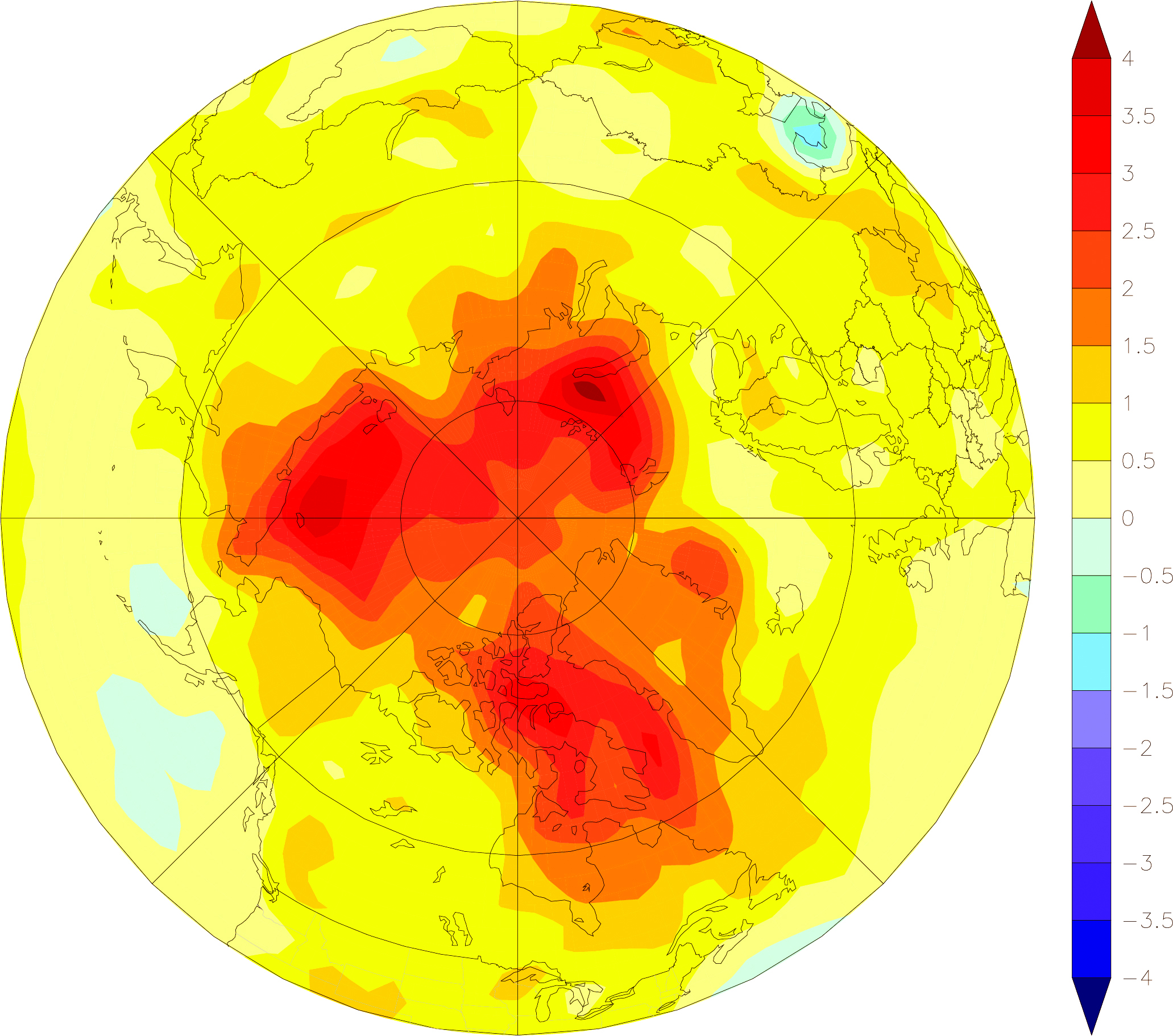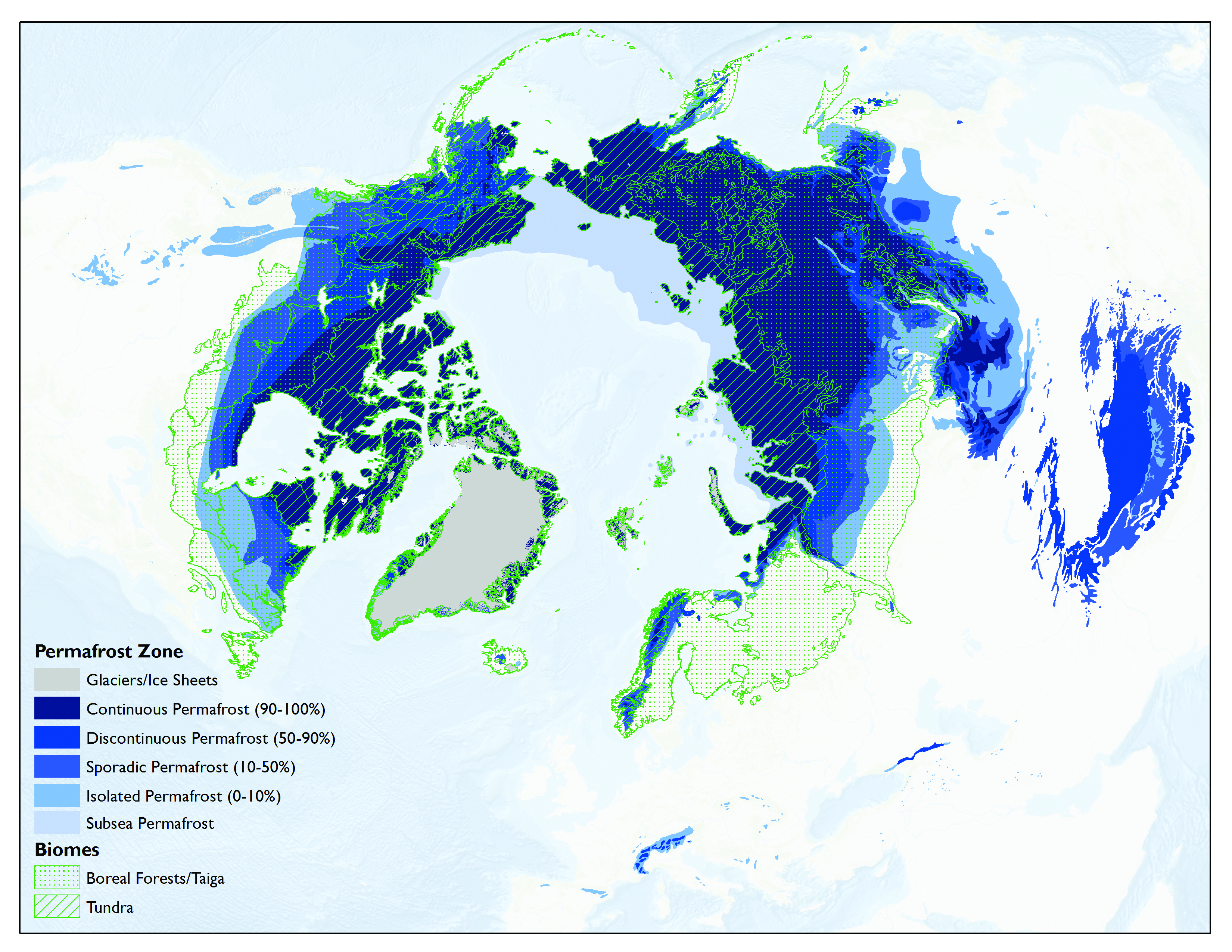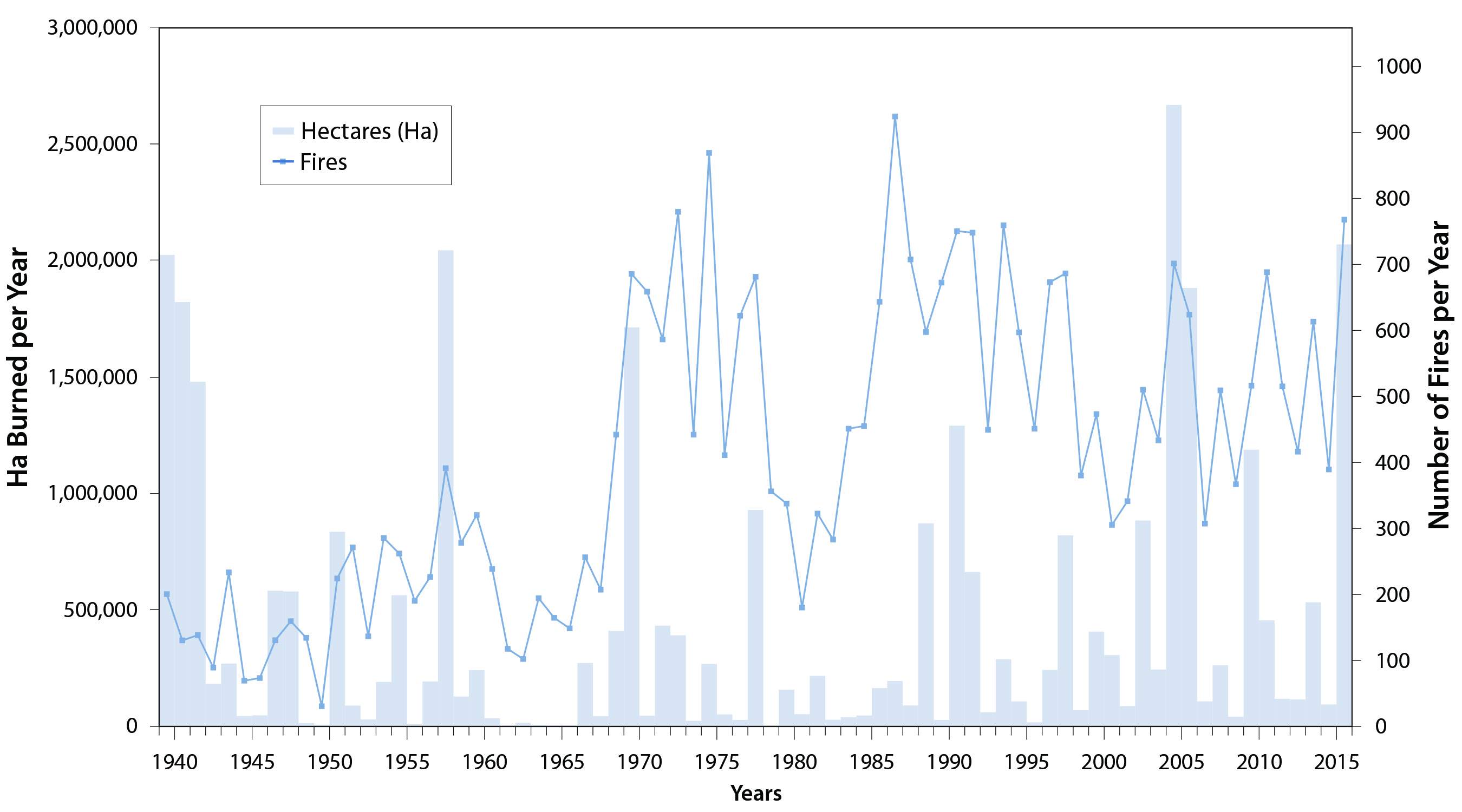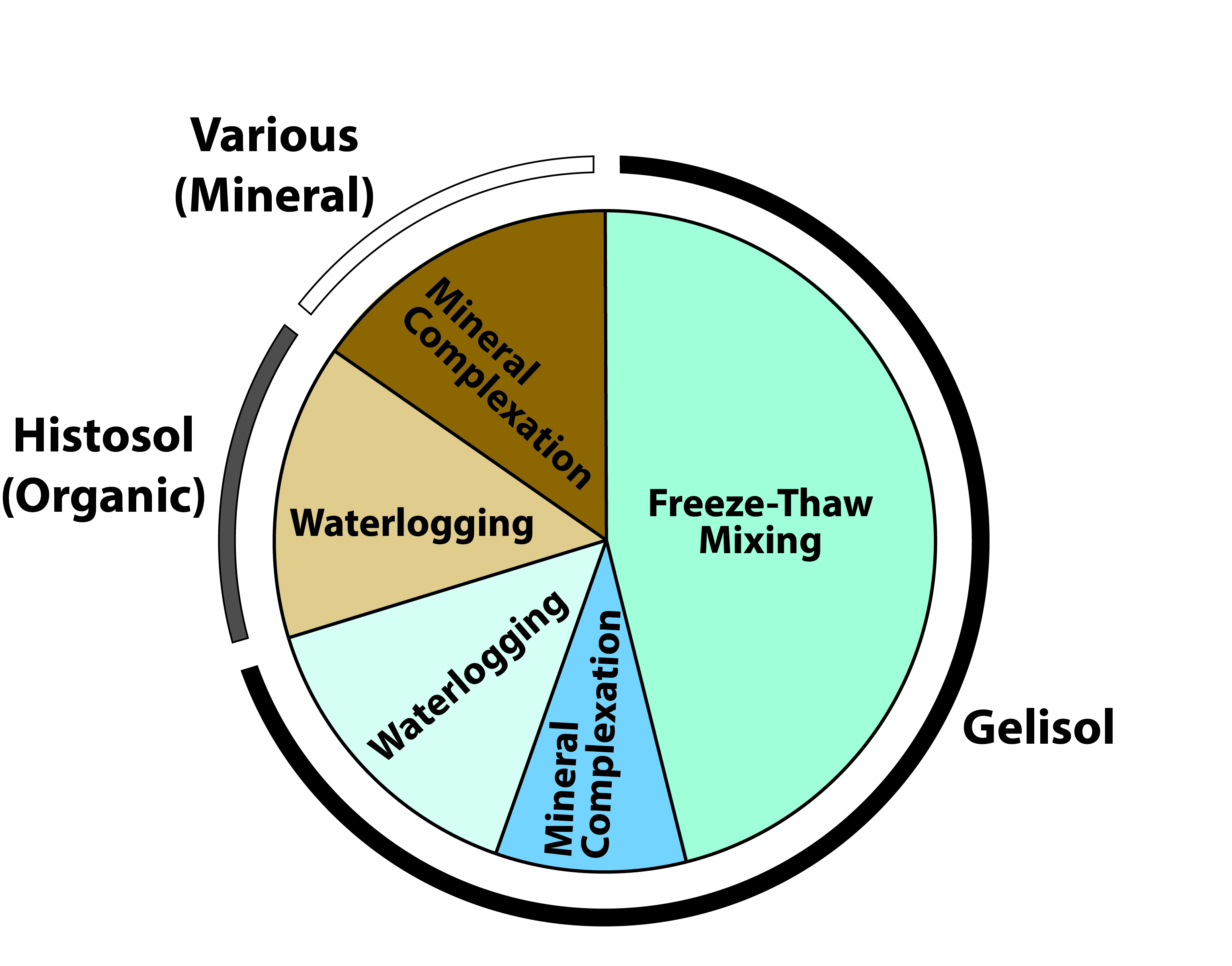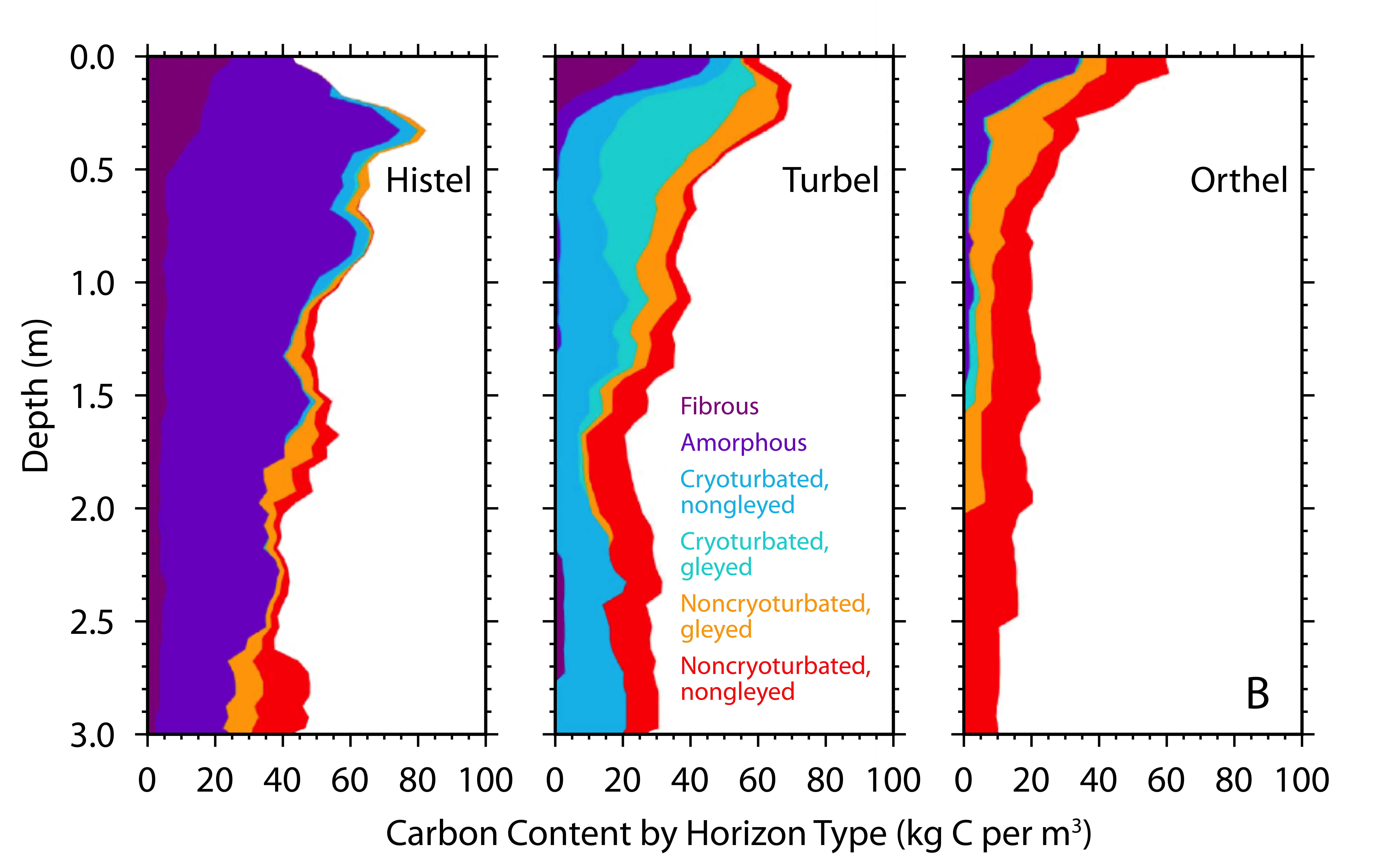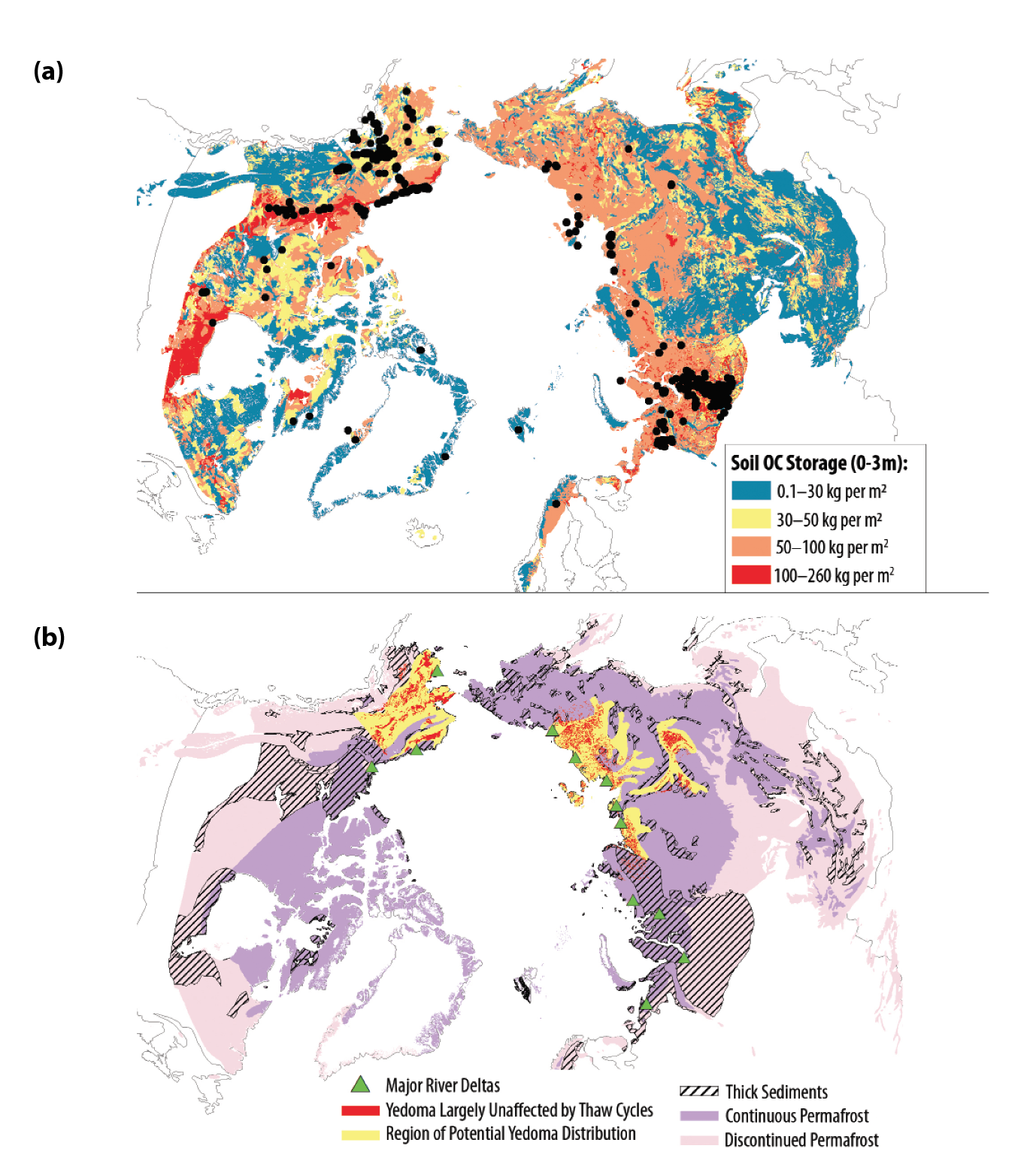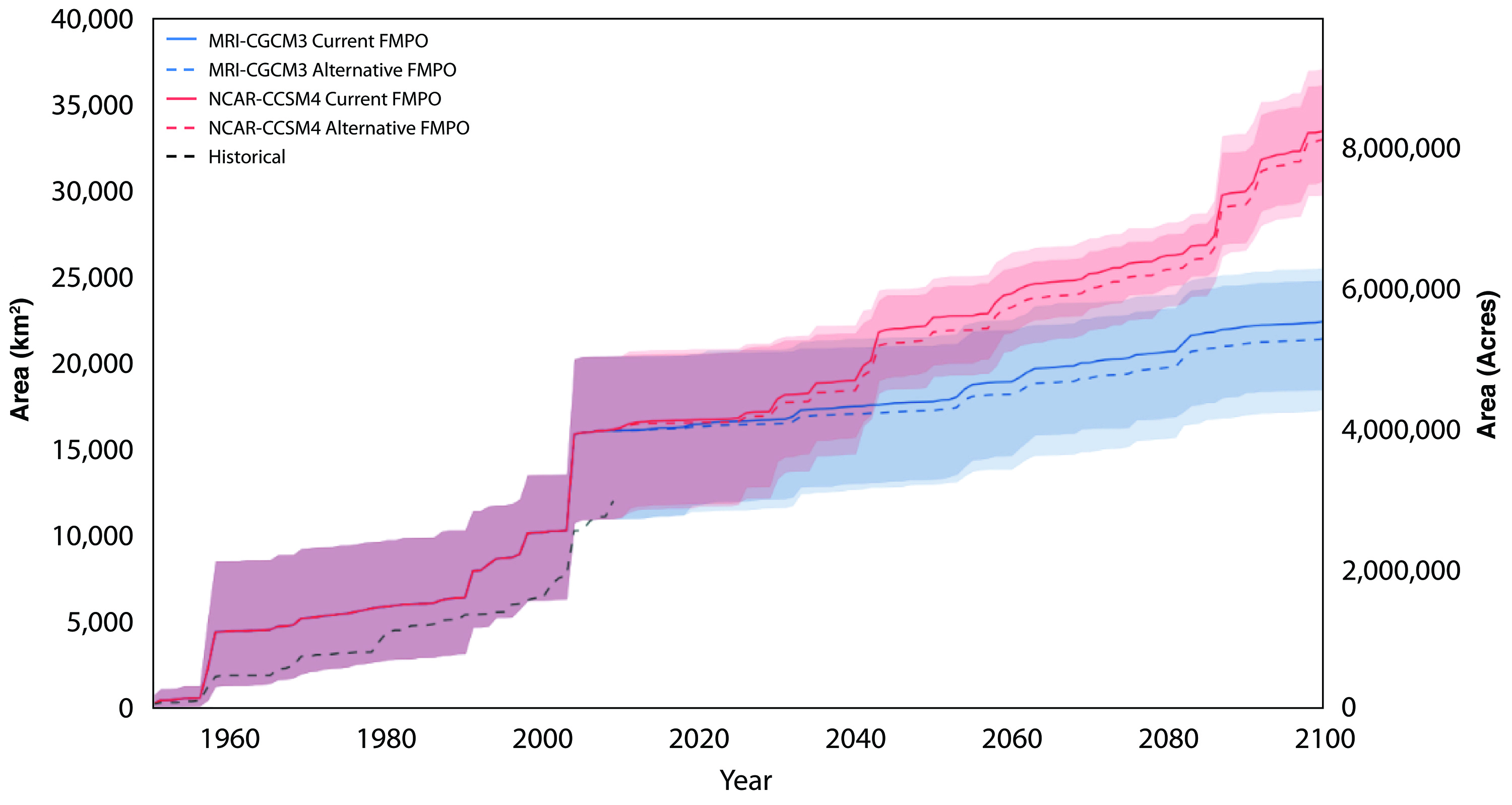11.4.1 Drivers of Carbon Pool Change
Changes in soil and vegetation carbon pools are a result of changing carbon fluxes over time. In the absence of pulse disturbances, CO2 exchange between ecosystems and the atmosphere is the major pathway of carbon input and output (Chapin et al., 2006). Carbon dioxide enters ecosystems via plant photosynthesis and is returned to the atmosphere through respiration of plants and all heterotrophic organisms that depend directly or indirectly on energy contained in plant biomass. Over the past few centuries to millennia, tundra and boreal ecosystems acted as net carbon sinks at the regional scale, as the amount of carbon released by respiration was smaller than that absorbed by photosynthesis. Vegetation biomass is likely to have reached peak amounts over decades to perhaps a century or more. In contrast, soils act as a long-term (i.e., century to millennia) carbon sink as carbon continues to accumulate as dead organic matter (Harden et al., 1992). Carbon accumulation resulting from the net difference between photosynthesis and respiration also is punctuated by periods of abrupt loss catalyzed by ecological disturbances. In the tundra and boreal biomes, large-scale pulse disturbances include fire, insect outbreaks, and abrupt permafrost thaw and soil subsidence (known as thermokarst). Periods of disturbances generally favor carbon losses either abiotically (e.g., fire emissions) or biotically (e.g., stimulating respiration). These losses often occur as a pulse loss, whereas carbon gains through vegetation growth and succession and new soil carbon accumulation occur over decadal to century timescales. Other smaller but important carbon fluxes in high-latitude ecosystems include CH4 flux and the lateral export of dissolved inorganic carbon (DIC), dissolved organic carbon (DOC), and particulate organic carbon (POC) in water (McGuire et al., 2009). Methane flux by weight is usually an order of magnitude smaller than CO2 flux but has a higher global warming potential (GWP). Dissolved carbon losses are a persistent feature of undisturbed and disturbed ecosystems and also are typically an order of magnitude smaller than CO2 exchanges. An exception is POC, which usually is similar in magnitude to other dissolved losses and relatively small in many circumstances. However, it is the one flux that can approach the magnitude of CO2 exchanges, at least for short periods, when erosion is a consequence of another disturbance such as abrupt permafrost thaw or fire.
11.4.2 Carbon Fluxes in Recent Decades
Stock Changes
Changes in vegetation and soil carbon stocks over time provide an estimate of landscape carbon budgets. For boreal and Arctic ecosystems, the challenge is that study sites are remote and often not spatially representative. Inventories of aboveground plant biomass in forests are probably the best measured of all ecosystem carbon pools, along with harvested wood products (i.e., managed forests) and then deadwood. Rather than estimated through time, belowground biomass, litter, and soil stocks usually are estimated from single time-point measurements and extrapolated using simple scaling assumptions. The most recent regional estimates for Eurasian and Canadian boreal forests put total carbon flux (total of all pools described above) at 493 ± 76 teragrams (Tg) C per year from 1990 to 1999 and at 499 ± 83 Tg C per year from 2000 to 2007 (Pan et al., 2011). These estimates do not include forestland in interior Alaska (0.51 × 106 km2) or unmanaged forests in northern Canada (1.18 × 106 km2), essentially assuming those lands to be at steady state in regard to carbon pools.
Carbon Dioxide
Recent syntheses have outlined changes in tundra carbon flux over time. A broad survey of data from a number of dry to wet tundra types found that in most studies since 1995, tundra acts as a carbon sink during summer, when photosynthetic uptake exceeds respiration losses during this approximately 100-day season (McGuire et al., 2012). Summer carbon sequestration is offset partially by carbon losses in fall, winter, and spring when microbes are still metabolically active and releasing CO2, while plants are largely dormant and carbon assimilation has slowed or ceased. While absolute levels of CO2 flux are low during the nonsummer season, the long period of more than 250 days is enough to offset, in some cases, the net carbon that accumulated during summer. A critical issue for determining net change in ecosystem carbon storage is the relative scarcity of nonsummer flux measurements in comparison to summer flux measurements. For example, the recent regional carbon balance estimate for the North American subregion had 80 study-years of summer measurements and only 9 study-years of nonsummer measurements available for upscaling (McGuire et al., 2012). This order of magnitude difference across seasons was similar across the other upscaled tundra subregions.
A first-order upscaling synthesis that used plot-scale measurements scaled by regional land area showed that North American tundra was a source of carbon on the order of 124 Tg C per year during the 1990s and a sink of 13 Tg C per year during the 2000s (McGuire et al., 2012). This increase in uptake relative to losses was similar to that in the Eurasian tundra that was reported as a 19 Tg C per year source in the 1990s and a sink of 185 Tg C per year in the 2000s. This study reported a global carbon exchange in the tundra region of 13 Tg C per year (i.e., a small sink but near neutral exchange) over both decades using a scaling region of 9.2 × 106 km2, which includes the tundra biome plus a portion of the boreal forest biome for comparison to large-scale atmospheric inversion models. A follow-up synthesis study focused on a subset of the same tundra sites and also included new sites with nonsummer data to bolster undersampled seasons (Belshe et al., 2013). Although this analysis supported the previous finding that the summer-season carbon sink increased in the 2000s compared with the 1990s, it suggested that the mean tundra flux remained a carbon source annually across both decades when additional nonsummer flux data were included. In this analysis, the source potential appears to decline over time, although this decline is statistically nonsignificant. Separately analyzing the record for the nonsummer data-intensive period (2004 to 2010) showed a trend of increasing nonsummer carbon flux and an overall increase in tundra carbon source during that period. Because changes in measurement technology parallel trends in time, data also were analyzed relative to the mean annual temperatures of the study sites. The trend of tundra consistently acting as an annual carbon source was significant across the range of tundra sites, with the net loss ranging from 23 to 56 grams (g) C per m2 per year. This relationship also predicts a 2 g C per °C increase in loss rates across the range of mean annual temperatures. These figures, when scaled to a region consistent with the previous study (10.5 × 106 km2; Callaghan et al., 2004; McGuire et al., 1997, 2012), predict that the tundra is acting as current source of 462 Tg C per year that could increase by almost 35% to 620 Tg C per year, given the “business-as-usual” warming projected for the Arctic (i.e., an increase of 7.5°C).
Recent measurements of atmospheric GHG concentrations over Alaska have been used to estimate carbon source and sink status of those Arctic and boreal ecosystems for 2012 to 2014 (Commane et al., 2017). During this period, tundra regions of Alaska were a consistent net CO2 source to the atmosphere, whereas boreal forests were either neutral or a net CO2 sink. The larger interannual variability of boreal forests was due both to changes in the balance of photosynthesis and respiration and to the amount of combustion emissions by wildfire. The Alaska study region as a whole was estimated to be a net carbon source of 25 ± 14 Tg C per year averaged over the land area of both biomes for the entire study period. If this Alaskan region (1.6 × 106 km2) was representative of the entire northern circumpolar permafrost zone soil area (17.8 × 106 km2), this amount would be equivalent to a region-wide net source of 0.3 Pg C per year.
Methane
Uncertainty in the scaling of “bottom-up” field-based flux observations of CH4 emissions across the northern permafrost region (32 to 112 Tg CH4 per year; McGuire et al., 2009) is much larger than uncertainty from “top-down” atmospheric analyses based on the spatial and temporal variability of CH4 concentration measurements (15 to 50 Tg CH4 per year; McGuire et al., 2009; Crill and Thornton 2018). Flux estimates include those from terrestrial ecosystems (e.g., wetlands), lakes, and coastal waters underlain by permafrost. Observational studies reviewed by McGuire et al. (2012) indicate that during the 1990s and 2000s, the tundra emitted 14.7 Tg CH4 per year (with an uncertainty range of 0 to 29.3 Tg CH4 per year). Kirschke et al. (2013) suggest a Eurasian boreal wetland source of 14 Tg CH4 per year (uncertainty = 9 to 23) from field flux measurements and 9 Tg CH4 per year (uncertainty = 4 to 13) from atmospheric measurements, which also estimate an upland soil sink of 3 Tg CH4 per year (uncertainty = 1 to 5). For North American high-latitude wetlands, estimated emissions are 9 Tg CH4 per year (uncertainty = 6 to 17) from atmospheric measurements and 16 Tg CH4 per year (uncertainty = 9 to 28) from field flux measurements, along with a soil sink of 2 Tg CH4 per year (uncertainty = 1 to 2) estimated from atmospheric measurements. The most recent assessment reports that the field flux uncertainty in CH4 emissions from tundra terrestrial ecosystems and lakes in the Arctic was between 10 and 43 Tg CH4 per year during the 1990s and 2000s (AMAP 2015). This estimate indicates that bottom-up uncertainties have not been reduced by more recent assessments. Estimates of CH4 fluxes from lakes likely are confounded with those from wetlands in spatial scaling procedures. A recent synthesis that focused just on lakes in the northern permafrost region indicates that CH4 emissions from lakes range from 6 to 25 Tg CH4 per year (Walter Anthony et al., 2016; Wik et al., 2016). Also, there are large uncertainties about the magnitude of CH4 emitted from submarine permafrost in coastal waters of the Arctic Ocean and its marginal seas (Berchet et al., 2016; Shakhova et al., 2010, 2014). The degree to which the source of CH4 emissions in coastal waters results from biogenic methanogenesis, fossil sources, or the dissociation of gas hydrates is not clear. The amount of CH4 emitted from fossil sources is an issue for both land and ocean environments in the permafrost region. Emissions include CH4 from natural sources such as geological seeps and human activities, including oil and gas exploration and transport (Ruppel and Kessler 2017; Kohnert et al., 2017). Top-down estimates of CH4 emissions from the permafrost region are useful because they integrate the various sources of CH4 to the atmosphere. However, these top-down flux estimates also have substantial uncertainties because they are derived from models, which still need to be better reconciled with field flux measurements.
Recent developments include increased use of atmospheric measurements from aircraft, which have the great advantage of avoiding biases induced by logistical constraints on ground-based study site selections or “hotspot”-focused studies that ignore potentially vast areas of CH4 uptake (e.g., 3.2 ± 1.4 mg CH4 per m2 per day in dry tundra and 1.2 ± 0.6 mg CH4 per m2 per day in moist tundra in northeast Greenland; Juncher Jørgensen et al., 2015). Aircraft atmospheric measurements also inherently include previously neglected freshwater systems estimated to contribute as much as 13 Tg CH4 per year north of 54°N (Bastviken et al., 2011). A recent study used aircraft concentration data and inverse modeling to derive regional fluxes averaged over all of Alaska amounting to 2.1 ± 0.5 Tg CH4 from May to September 2012 (Chang et al., 2014). This quantity includes all biogenic, anthropogenic, and geological sources such as seeps, which alone contribute an estimated 1.5 to 2 Tg CH4 per year (Walter Anthony et al., 2012), based on extrapolating ground-based measurements.
Spatial analyses of CH4 emissions in the northern permafrost region indicate that “wetter” wetlands are primarily sensitive to variation in soil temperature, whereas “drier” wetlands are primarily sensitive to changes in water-table position (Olefeldt et al., 2013). Similar analyses for lakes indicate that in systems with suitable organic substrate, CH4 emissions are sensitive to water temperature, particularly in the continuous permafrost zone (Wik et al., 2016). In addition, some studies have proposed that seasonality of CH4 emissions is potentially sensitive to ongoing climate change, with emissions possibly persisting further into fall as soils remain unfrozen for longer periods (Mastepanov et al., 2008; Miller et al., 2016; Zona et al., 2016) or elevating in spring as CH4 is released from trapped pockets in the frozen soil (Raz-Yaseef et al., 2016). These sensitivities suggest that observed changes in temperature of the northern permafrost region should have resulted in increased CH4 emissions (Walter Anthony et al., 2016), and modeling studies that have incorporated these sensitivities conclude this as well (Riley et al., 2011; Xu et al., 2016). However, while temperature has increased substantially in the northern permafrost region in recent decades, there is no indication from analyses of atmospheric data that CH4 emissions in the region have increased (Bergamaschi et al., 2013; Bruhwiler et al., 2014; Dlugokencky et al., 2009; Sweeney et al., 2016). The lack of significant long-term trends suggests more complex biogeochemical processes may be counteracting the observed short-term temperature sensitivity (Sweeney et al., 2016). Alternatively, separating biogenic changes in northern ecosystems from fossil-fuel derived emissions from lower latitudes may be difficult using surface atmospheric concentration measurements alone (Parazoo et al., 2016).
Lateral Hydrologic Losses
Carbon can move laterally into inland waters from terrestrial upland and wetland ecosystems in Arctic and boreal biomes. In inland waters, carbon derived from living and dead organic matter is transported largely to the ocean as DOC, DIC, and POC (see Ch. 14: Inland Waters). The annual export of carbon from rivers to the Arctic Ocean is estimated to be 43 Tg C as DIC, 33 Tg C as DOC, and 6 Tg C as POC, for a total of 82 Tg C per year (McGuire et al., 2009). A recent assessment for Alaska estimates that the riverine flux of DIC, DOC, and POC to the ocean is 18 to 25 Tg C per year (Stackpoole et al., 2016), representing 22% to 30% of the total riverine flux of carbon to the Arctic Ocean estimated by McGuire et al. (2009). Although this percentage of the total appears large for Alaska relative to its small geographic discharge area, it may indicate that earlier estimates were too low (McGuire et al., 2009).
Coastal erosion in the Arctic is an important source of POC to the Arctic Ocean, and this flux is likely to increase with warming because of enhanced erosion associated with the loss of a protective sea ice buffer, increasing storm activity, and thawing of coastal permafrost (e.g., Jorgenson and Brown 2005; Rachold et al., 2000, 2004). Based on recent estimates (Rachold et al., 2004), POC transport across the Arctic land-ocean interface through coastal erosion is about 6 to 7 Tg C per year (McGuire et al., 2009).
Fire
Fire has the largest footprint of any pulse disturbance in the northern circumpolar permafrost zone; thus, increases in the size, frequency, and severity of regional fire regimes will have important impacts on current and future carbon stocks and fluxes (Balshi et al., 2009; Bond-Lamberty et al., 2007; Kasischke et al., 1995). At the ecosystem scale, fire catalyzes abrupt changes in stocks by transferring carbon from plants and soils to the atmosphere. In contrast to temperate and tropical wildfires, soil organic matter is the dominant source of carbon emissions from boreal and tundra wildfires, and fire-driven changes in soil structure can alter controls over ecosystem carbon dynamics such as ALT, hydrology, and vegetation age and composition. At the landscape scale, increasing fire activity will alter the age structure of forests and tundra, decreasing landscape carbon stocks and increasing or, perhaps less frequently, decreasing carbon sequestration (Yue et al., 2016).
Estimates of carbon emissions from global boreal forest fires averaged 155 Tg C per year (with a range of 78 to 334 Tg C per year) from 1997 to 2013 (Giglio et al., 2013; van der Werf et al., 2010). North American boreal forests contributed 7% to 79% of these emissions and averaged 30%, which is similar to their proportional area (see Table 11.2). However, recent extreme fire years (2014 in northern Canada and 2015 in Alaska) doubled emissions from this region to about 100 Tg C per year, similar to average emissions from the much larger Eurasian boreal region. Extreme fire years are common in both regions. For example, within the last 19 years, North American boreal forests had 6 years where emissions were double the long-term average of 56 Tg C per year, and boreal Eurasian forests had 3 years with emissions double the long-term average of 106 Tg C per year. In contrast to the boreal forest, global carbon emissions from tundra wildfires are poorly constrained, but, on a per-unit-burned-area basis, tundra emissions can be similar in magnitude to boreal forest emissions because of the deep burning of organic soils (Mack et al., 2011). This finding suggests that increased tundra burning will have a similar per-unit-area impact to increased boreal forest burning.
Regional patterns of changing fire severity are less understood than changes in area. Increases in fire frequency are important because they reduce carbon recovery time post-fire and make forests more vulnerable to high-intensity fires (Hoy et al., 2016) or shifts in vegetation dominance (Brown and Johnstone 2012). In permafrost-affected soils, a large quantity of organic carbon resides in a thick soil organic layer that can be hundreds to thousands of years old; this carbon is a legacy of past fire cycles (Harden et al., 2000). Combustion of the soil organic layer dominates carbon emissions during fires (Boby et al., 2010; Kasischke et al., 1995; Mack et al., 2011), and more severe fires result in deeper burning (Turetsky et al., 2011a). Because soil carbon accumulation rates vary across the landscape (Hobbie et al., 2000), deeper burning may not always combust legacy carbon (Mack et al., 2011), but when it does, this burning could rapidly shift ecosystems across a carbon cycling threshold, from net accumulation of carbon from the atmosphere over multiple fire cycles to net loss (Turetsky et al., 2011b).
Fires that burn deeply into the soil organic layer can persistently alter both physical and biological controls over carbon cycling, including permafrost stability, hydrology, and vegetation. Reduction or loss of the soil organic layer decreases ground insulation (Jiang et al., 2015; Jorgenson 2013; Jorgenson et al., 2013; Shur and Jorgenson 2007), warming permafrost soils and exposing organic matter that has been frozen for hundreds to thousands of years to microbial decomposition, mineralization, and atmospheric release of GHGs (Schuur et al., 2008). Permafrost degradation also can increase or decrease soil drainage, leading to abrupt changes in soil moisture regimes that affect both decomposition and production (Jorgenson 2013; Jorgenson et al., 2013; Schuur et al., 2009). These changes sometimes lead to abrupt permafrost thaw and thermal erosion events that drive further change in ecosystem processes. In addition, loss of the soil organic layer exposes mineral soil seedbeds (Johnstone et al., 2009), leading to recruitment of deciduous tree and shrub species that do not establish on organic soil (Kasischke and Johnstone 2005). This recruitment has been shown to shift post-fire vegetation to alternate successional trajectories (Johnstone et al., 2010). Model projections suggest that the Alaskan boreal forest could cross a tipping point, where recent increases in fire activity have made deciduous stands as abundant as spruce stands on the landscape (Mann et al., 2012). In Arctic Larix forests of northeastern Siberia, increased fire severity can lead to increased tree density in forested areas and forest expansion into tundra (Alexander et al., 2012). Additionally, burned graminoid tundra has been observed to increase in post-fire greenness (Hu et al., 2015), an occurrence that has been linked to increased tall deciduous shrub dominance (Racine et al., 2004; Rocha et al., 2012). Plant-soil-microbial feedbacks within new vegetation types determine long-term trajectories of nutrient dynamics (Melvin et al., 2015) that, in turn, constrain ecosystem carbon storage (Alexander and Mack 2016; Johnstone et al., 2010) and resultant climate feedbacks via carbon and energy (Randerson et al., 2006; Rocha et al., 2012).
11.4.3 Future Vulnerabilities
Carbon in Arctic and boreal ecosystems is expected to be subject both to press disturbances such as increasing temperatures, changing precipitation regimes, and rising CO2 and to pulse disturbances including wildfire, insect outbreaks, and abrupt permafrost thaw. Rates of both disturbance types may change over time depending on future human activities and the resulting ecosystem- and landscape-level feedbacks. No single future assessment technique includes all these mechanisms comprehensively. This section provides estimates of carbon pool change using three different assessment techniques: 1) semiquantitative assessment that relied on expert knowledge of the system; 2) dynamical models that relied on environmental input data and knowledge of underlying mechanistic relationships of ecosystem dynamics; and 3) upscaling of laboratory measurements of potential soil carbon change.
Expert Assessment
To provide an integrated assessment of the effect of environmental changes in combination with heterogeneity in permafrost decomposability across the region, experts were asked to provide quantitative estimates of permafrost carbon change in response to four scenarios of warming (Schuur et al., 2013). For the highest warming scenario (RCP8.5), experts hypothesized that carbon release from permafrost zone soils could be 19 to 45 Pg C by 2040, 162 to 288 Pg C by 2100, and 381 to 616 Pg C by 2300 in CO2 equivalent using a 100-year CH4 GWP. The values become 50% larger using a 20-year CH4 GWP, with one-third to one-half of expected climate forcing coming from CH4, even though it accounted for only 2.3% of the expected carbon release. Experts projected that two-thirds of this release could be avoided under the lowest warming scenario (RCP2.6; Schuur et al., 2013). According to the experts, changes in tundra and boreal vegetation biomass were smaller, totaling an increase of about 15 Pg C by 2100 under the highest warming scenario (RCP8.5; Abbott et al., 2016). In contrast to soil, assessment of biomass change was more divergent among experts, with one-third of respondents predicting either no change, or even a decrease, in biomass over all time intervals and warming scenarios that were considered.
Model Projections
A number of ecosystem models and ESMs have incorporated a first approximation of global permafrost carbon dynamics. Recent key improvements include the physical representation of permafrost soil thermodynamics and the role of environmental controls (particularly the soil freeze-thaw state) in organic carbon decomposition (Koven et al., 2011, 2013; Lawrence et al., 2008). These improved models specifically address processes known to be important in permafrost ecosystems but were missing from earlier model representations. They have been key to forecasting the potential release of permafrost carbon with warming and the impact this release would have on the rate of climate change. Model scenarios show potential carbon release from the permafrost zone ranging from 37 to 174 Pg C by 2100 under the current climate warming trajectory (RCP8.5), with an average across models of 92 ± 17 Pg C (mean ± standard error [SE]); Burke et al., 2012, 2013; Koven et al., 2011; MacDougall et al., 2012; Schaefer et al., 2011; Schaphoff et al., 2013; Schneider von Deimling et al., 2012; Zhuang et al., 2006). This range is generally consistent with several newer, data-driven modeling approaches that estimated soil carbon releases by 2100 (for RCP8.5) to be 57 Pg C (Koven et al., 2015) and 87 Pg C (Schneider von Deimling et al., 2015), as well as an updated estimate of 102 Pg C from one of the previous models (MacDougall and Knutti, 2016). Furthermore, thawing permafrost carbon is forecasted to affect global climate for centuries. Models that projected emissions further out into the future beyond 2100 estimated additional carbon releases beyond those reported above. More than half of eventual total permafrost carbon emissions projected by the models, on average, would occur after 2100. While carbon releases over these time frames are understandably uncertain, they illustrate the momentum of a warming climate that thaws near-surface permafrost, causing a cascading release of GHGs, as microbes slowly decompose newly thawed permafrost carbon. The latest model simulations performed either with structural enhancements to better represent permafrost carbon dynamics (Burke et al., 2017) or with common environmental input data (McGuire et al., 2016) show similar soil carbon losses. However, they also indicate the potential for stimulated plant growth (e.g., with increased nutrients, temperature and growing season length, and CO2 fertilization) to offset some or all of these losses by sequestering new carbon into plant biomass and increasing inputs into the surface soil (McGuire 2018).
Within the wide uncertainty of forecasts, some broader patterns are just beginning to emerge. Models vary widely when predicting the current pool of permafrost carbon, which is the fuel for future carbon emissions in a warmer world. The model average size of the permafrost carbon pool was estimated at 771 ± 100 Pg C (mean ± SE), about half as much as the measurement-based estimate (Schuur et al., 2015). The difference in the two estimates potentially is related, in part, to the fact that most models represented carbon to a depth of only 3 m. A smaller modeled carbon pool, in principle, could constrain forecasted carbon emissions. Normalizing the emissions estimates from the dynamic models by their initial permafrost carbon pool size, 15 ± 3% (mean ± SE) of the initial pool is expected to be lost as GHG emissions by 2100 (Schaefer et al., 2014). However, within these complex models, sensitivity to modeled Arctic climate change and the responses of soil temperature, moisture, and carbon dynamics are important controls over emissions predictions, not just pool size alone (Koven et al., 2013; Lawrence et al., 2012; Slater and Lawrence 2013).
These dynamic models also simultaneously assess the countering influence of plant carbon uptake that may partially offset permafrost carbon release. Warmer temperatures, longer growing seasons, elevated CO2, and increased nutrients released from decomposing organic carbon all may stimulate plant growth (Shaver et al., 2000). New carbon can be stored in larger plant biomass or deposited into surface soils (Sistla et al., 2013). An intercomparison of biogeochemical models applied to the permafrost region indicates much larger plant production responses to climate change in the last few decades than observation-based trends in plant productivity (McGuire et al., 2016), suggesting that future plant production responses to changing climate may also be less than models predict. A previous generation of ESMs that did not include permafrost carbon mechanisms but did simulate changes in plant carbon uptake estimated that the vegetation carbon pool could increase by 17 ± 8 Pg C by 2100, with increased plant growth also contributing to new soil carbon accumulation of similar magnitude (Qian et al., 2010). The models reviewed here with permafrost carbon mechanisms also include many of the same mechanisms that stimulate plant growth as the previous generation of models and generally indicate that increased plant carbon uptake will more than offset soil carbon emissions from the permafrost region for several decades as the climate becomes warmer (Koven et al., 2011; MacDougall et al., 2012; Schaefer et al., 2011). Over longer timescales and with continued warming, however, microbial release of carbon overwhelms the capacity for plant carbon uptake, leading to net carbon emissions from permafrost ecosystems to the atmosphere. Modeled carbon emissions projected under various warming scenarios translate into a range of 0.13 to 0.27°C additional global warming by 2100 and up to 0.42°C by 2300, but currently remain one of the least constrained biospheric feedbacks to climate (IPCC 2013).
In many of the model projections previously discussed, CH4 release is not explicitly represented because fluxes are small. However, the higher GWP of CH4 makes these emissions relatively more important than on a mass basis alone. Observed short-term temperature sensitivity of CH4 from the Arctic possibly will have little impact on the global atmospheric CH4 budget in the long term if future trajectories evolve with the same temperature sensitivity (Sweeney et al., 2016). Global models that include the short-term sensitivities of CH4 to warming show increased CH4 emissions with future warming in the northern permafrost region (Gao et al., 2013; Riley et al., 2011). Yet, these models conclude that if these increased emissions were to occur, they would have little influence on the climate system because of their relatively small magnitude. However, most models do not include abrupt thaw processes (i.e., thawing of ice-rich permafrost) that can result in lake expansion, wetland formation, and massive erosion and exposure to decomposition of previously frozen carbon-rich permafrost. A substantial area of the northern permafrost region is susceptible to abrupt thaw (Olefeldt et al., 2016), which could result in more substantial CH4 emissions in the future than are currently projected by models. Although the current generation of comprehensive ESMs largely do not include abrupt thaw processes, progress is being made to include surface subsidence that occurs as a result of ground ice loss (Lee et al., 2014). A recent study suggests that the largest CH4 emission rates will occur around the middle of this century when simulated thermokarst lake extent is at its maximum and when abrupt thaw under thermokarst lakes is taken into account (Schneider von Deimling et al., 2015). Furthermore, the simulated CH4 fluxes can cause up to 40% of total permafrost-affected radiative forcing in this century. Similarly, no global models currently consider the effects of warming on CH4 emissions from coastal systems in the Arctic. Models clearly need to include an expanded suite of processes, such as those described previously, that can affect CH4 dynamics (Xu et al., 2016). These more comprehensive CH4 models must be effectively benchmarked in a retrospective context (McGuire et al., 2016) before the research community can reduce uncertainty over changes in CH4 dynamics of the northern permafrost region in response to future warming.
Laboratory-Based Empirical Upscaling
In addition to the amount of carbon stored in permafrost, the decomposability of organic matter determines how much carbon is released to the atmosphere. A recent synthesis using permafrost soil from various circumpolar locations assessed the decomposability of permafrost carbon using long-term (longer than 1 year) aerobic incubation studies (Schädel et al., 2014). A small fraction of organic matter in thawed permafrost can decompose in weeks to months (Bracho et al., 2016; Dutta et al., 2006; Knoblauch et al., 2013; Lee et al., 2012), but the larger fraction decomposes over decades and even centuries (Schädel et al., 2014). Decade-long potential carbon release as CO2 was estimated to range from 1% to 76% across a variety of soil types with strong landscape-scale variation. This landscape variation in decomposability was linked to the carbon-to-nitrogen ratio of the bulk organic matter, with higher ratio soils having a greater potential to release carbon during laboratory incubation. The carbon-to-nitrogen ratio is initiated by 1) the type of vegetation carbon that is input to the permafrost soil pool over years, centuries, and even longer; 2) subsequent microbial activity acting on those inputs; and 3) pedogenic processes that help control soil organic matter formation and decay. Upscaling these incubation results using a data-driven modeling approach estimated that soil carbon releases by 2100 (for RCP8.5) will be 57 PgC (Koven et al., 2015).
In a future climate, microbial decomposition of organic matter will happen under a wide variety of environmental conditions that control the amount and form of GHG release. Although temperature control over decomposition is implicit when considering permafrost thaw, northern high latitudes also are characterized by widespread lakes, wetlands, and waterlogged soils. Oxygen-rich conditions are found in drier upland soils where microbial decomposition produces mainly CO2; oxygen-poor conditions occur in lowlands when ice-rich permafrost thaws, runoff is prevented by the underlying permafrost, and both CO2 and CH4 are produced by microbial decomposition. A recent meta-analysis compared GHG release from aerobic and anaerobic laboratory incubation conditions (Schädel et al., 2016). The study quantified that drier, aerobic soil conditions result in three times higher carbon release into the atmosphere compared to the same soil decomposing in wetter, anaerobic soil conditions. Most of the carbon released to the atmosphere was in the form of CO2. Under anaerobic conditions, a small amount of carbon also was released as CH4 (about 5% of total carbon release). Even though CH4 is the more potent GHG, the much faster decomposition under aerobic conditions dominates the overall carbon release from permafrost. These results show that CO2 released from drier and oxygen-rich environments will be as or more important than CO2 and CH4 released from oxygen-poor environments on a per-unit soil carbon basis. The ultimate effect of these ecosystem types on climate would be scaled, of course, by the landscape coverage of these drier and wetter environments. In addition, these results present laboratory potentials for GHG release from permafrost; there are variety of factors excluded from this technique, such as increased plant biomass input to the soils, changing plant communities, and the priming of old carbon decomposition from new plant litter inputs.
